Cool- Paris is a website in which covers information on Hotels, tour,food,shopping,sightseeing,and more. You are experiencing Paris without even visiting!
 Welcome,Guest User
Welcome,Guest User
Home > Paris
Cool- Paris is a website in which covers information on Hotels, tour,food,shopping,sightseeing,and more. You are experiencing Paris without even visiting!
Home > Paris

Paris, the cosmopolitan capital of France, is one of the largest agglomerations in Europe, with 2.2 million people living in the dense, central city and almost 12 million people living in the whole metropolitan area. Located in the north of France on the river Seine, Paris has the reputation of being the most beautiful and romantic of all cities, brimming with historic associations and remaining vastly influential in the realms of culture, art, fashion, food and design. Dubbed the City of Light (la Ville Lumière) and Capital of Fashion, it is home to the world's finest and most luxurious fashion designers and cosmetics, such as Chanel, Dior, Yves Saint-Laurent, Guerlain, Lancôme, L'Oréal, Clarins, etc. A large part of the city, including the River Seine, is a UNESCO World Heritage Site. The city has the second highest number of Michelin-restaurants in the world (after Tokyo) and contains numerous iconic landmarks, such as the world's most visited tourist site the Eiffel Tower, the Arc de Triomphe, the Notre-Dame Cathedral, the Louvre Museum, Moulin Rouge, Lido etc, making it the most popular tourist destination in the world with 45 million tourists annually.
The 4th is a good chunk of what used to be medieval Paris, and you'll find a lot left from that time on both islands and in the narrow streets of the lower Marais. Meanwhile there's lots that's contemporary to look at especially at the Centre Georges Pompidou where you'll find a lot of the very best contemporary art.
At night the 4th has several of the most active bar scenes most travelers will have ever seen, including the lower Marais district which is sometimes known as gay Paris although there are no shortage of bars catering to straight singles or a mixed crowd, or, in the early evening, families.
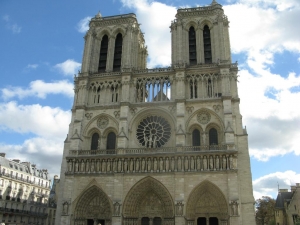
【Notre-Dame de Paris (Notre Dame Cathedral)】
The early Gothic Cathédrale de Notre Dame has a 12th century design but wasn't completed until the 14th. Still it is a good example of the development of the style, though the west or main portal is a bit unusual in its rigidity. Remember that this is an active church, there may even be a mass going on. Meanwhile anybody who's interested in history should check out the crypt, entered at the opposite end of the square, in which you can observe the foundation stones for buildings on the island going back to Roman times.
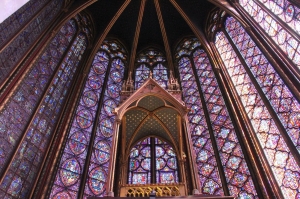
【Sainte Chapelle】
Soaring stained glass windows beaming ample light onto the rich primary colors of the tile mosaics on the floor, this photogenic church was built by the French kings to house the relics of the Crown of Thorn. Make sure you go on a sunny day, as the highlight of this small chapel in Rayonnante Gothic style are the large stained-glass windows which soar up to near the vaulted ceiling.
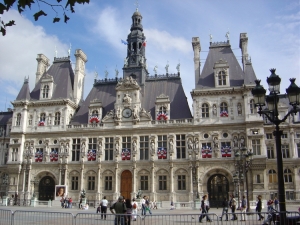
【Paris City Hall】
Paris city hall, is one of the loveliest buildings in town. The present Paris City Hall replaced the 16th century original which was burned down during the Commune in 1871. A pastiche of its predecessor, but on a far larger scale, it was built by the the architects Ballu and Deperthes, chosen after a competition, and was mostly completed by 1882. The building is lavishly, and some would say heavy-handedly, decorated both inside and out, and finished in an arrestingly white stone, similar to that used for the even more eye-catching Sacre-Coeur basilica.
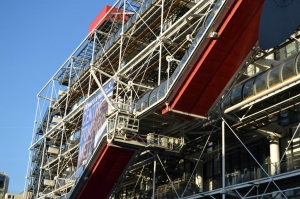
【Pompidou Centre】
Those who are unfamiliar with conceptual art sometimes don't know quite what to expect, or how to approach it. Such travelers should rest assured that the curators at the Pompidou Centre have assembled a marvelous introduction consisting of mostly approachable works which delight, amuse, and entertain.
The 18th arrondissement of Paris is probably best known for the hill of Montmartre which was the centre of the Communard uprising of the late nineteenth century, but is also perhaps better known as the centre of the flourishing artist community of the period from around 1907 to 1914. Picasso, Dali, Duchamp, Toulouse-Lautrec, and others from the vibrant early modern period lived and worked here until driven out either by political considerations during the First World War or rising property values thereafter. The 18th is also the home of a thriving ethnic community in the east and *was* a sort of a red-light district along Boulevard de Clichy near Place Pigalle.

【Le Moulin Rouge】
With two shows a night, this turn-of-the-20th century burlesque palace offers a big production choreographed dance show interspersed with comedians, jugglers, and magicians. The show is more than bilingual, and exaggerates the U.S. 4th infantry's involvement in the libération for the sake of the large number of Americans in the audience. Plan on arriving at least an hour early for the best seats.

【Sacré-Cœur】
The Basilica of the Sacred Heart of Paris, commonly known as Sacré-Cœur Basilica and often simply Sacré-Cœur, is a Roman Catholic church and minor basilica, dedicated to the Sacred Heart of Jesus, in Paris, France. A popular landmark, the basilica is located at the summit of the butte Montmartre, the highest point in the city. Sacré-Cœur is a double monument, political and cultural, both a national penance for the defeat of France in the 1871 Franco-Prussian War and the socialist Paris Commune of 1871 crowning its most rebellious neighborhood, and an embodiment of conservative moral order, publicly dedicated to the Sacred Heart of Jesus, which was an increasingly popular vision of a loving and sympathetic Christ.
The 9th arrondissement of Paris is a diverse, "in between" section of the French capital. The Grands Boulevards area of shopping throughfares and flagship department stores (as well as the original Opera - hence the common name for the district) is to be found in the southern part of the arrondissement (shared with the 2nd and the 8th). By way of contrast, the fading red-light and cheap shopping district of Pigalle is in the north of the 9th, closely adjoining Montmartre on the hill above in the 18th. In between the two, relatively-speaking, lies a traveller's no-man's-land / terra incognita - though the streets around St Lazare used to be the Impressionists stronghold in Paris.
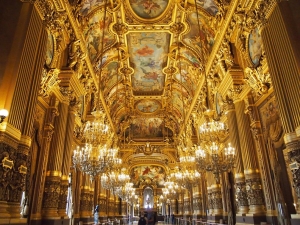
【Palais Garnier】
The Palais Garnier is a 1,979-seat opera house, which was built from 1861 to 1875 for the Paris Opera. It was originally called the Salle des Capucines because of its location on the Boulevard des Capucines in the 9th arrondissement of Paris, but soon became known as the Palais Garnier in recognition of its opulence and its architect, Charles Garnier. The theatre is also often referred to as the Opéra Garnier, and historically was known as the Opéra de Paris or simply the Opéra, as it was the primary home of the Paris Opera and its associated Paris Opera Ballet until 1989, when the Opéra Bastille opened at the Place de la Bastille. The Paris Opera now mainly uses the Palais Garnier for ballet.

【Galeries Lafayette】
The Galeries Lafayette is an upmarket French department store located on Boulevard Haussmann in the 9th arrondissement of Paris. In 2009, Galeries Lafayette recorded earnings of over one billion euro. It is a part of the company Groupe Galeries Lafayette.
The centre of contemporary Paris and the site of such landmarks as the Louvre and of the Tuileries and Palais-Royal, the 1st Arrondissement is full of attractions for travellers of all inclinations, including some of the finest parks, museums, shops, and bars in the city. The 1st occupies the Right Bank of the River Seine and extends onto the western section of the Île de la Cité in the midst of the river.
For occupying such a compact space, however the 1st feels remarkably different from one end to the other. The almost incredibly upscale western end of the arrondissement gives way to the hustle and bustle of the big city east of the Palais Royal, and then further east to the pedestrian dominated area around Les Halles and the Samaritaine, where tourists mix with Parisiens and Parisiennes in huge numbers .
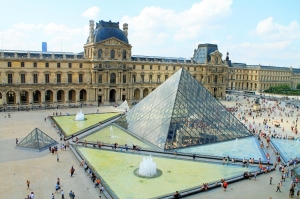
【Louvre Museum】
The primary landmark of the 1st arrondissement: as well as housing one of the world's great museums since 1793, the former palace offers some dazzling architecture, wide public spaces and the glass pyramid of I M Pei. Of course there's also quite a bit to see inside the building; see our coverage under Museums below. edit It's a palace of 65,000 meters squared - very large. If you're overwhelmed by this there's a company that offers themed treasure hunts that helps focus your visit and provides an overview of the museum. And there are other external companies that provide guided tours which help lessen the overwhelming-ness.
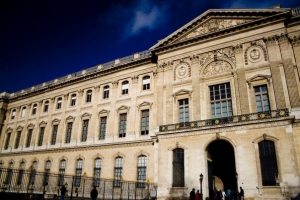
【Palais-Royal】
Ordered by Cardinal de Richelieu (1585-1642), King Louis XIIIth's prime Minister in 1629 (completed in 1636); originally called Palais Cardinal; it became Le Palais Royal when Anne d'Autriche, Louis XIIIth's wife, came to live here to get away from the Louvre palace. It eventually housed Louis the XIVth until the move to Versailles. It includes also a beautiful garden Les jardins du Palais Royal, enclosed within the buildings. It's been the theater of one of the seminal events of the French Revolution (Camille Desmoulins made a famous declaration here in 1789). The Théatre Français nearby was built in 1716. There are numerous restaurants inside the garden , including famous Le Grand Véfour. There's also the controversial Colonnes de Buren, striped columns installed within the inside yard among the XVIIth century architecture. edit These striped columns and column stumps are within the Ministry of Culture (those buildings surrounding it on three sides).
The 8th arrondissement of Paris is home to the Champs-Élysées, which ends up at the Arc de Triomphe. The executive branch of French government is also based here, as well as the embassies of certain nations such as the U.S. and the U.K. The French President also lives here, in the Élysée Palace.
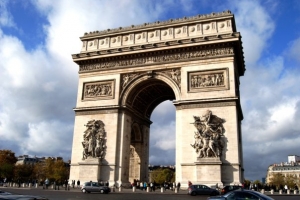
【Arc de triomphe】
This iconic triumphal arch forms the focus of the main east-west road axis of Paris, running between the Louvre and the Grande Arche de la Défense in the west. The monument was commissioned by Napoleon in 1806 as a tribute to his victories as Emperor of France - it was finally completed in 1836, long after his death. 50 m (150 ft) high and 45 m wide, the Arc de Triomphe is decorated with battle scenes and martial sculptures that includes La Marseillaise by Rude. More recently, the Tomb of the Unknown Soldier was placed beneath the arch in 1920, where an eternal flame burns in tribute to the French dead of both World Wars. The arch is surrounded by a large roundabout, aptly known as l'Etoile - 'the star' - with 12 thoroughfares leading off from it. Visitors can purchase a ticket to climb to the top of the arch, from where magnificent views spread out over western Paris. Admission to a small museum devoted to the history and meaning of the monument is included.

【The Madeleine Church】
Open 7AM - 7PM Mon-Sat, 8AM - 1.30PM and 3.30PM - 7PM Sun. One of the best-known and most beautiful churches in Paris, in the guise of a Corinthian order Classical temple. Construction started in 1764, although the church was not finally consecrated until 1845. The Madeleine has a lavish interior of marble and gold.
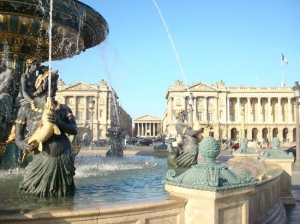
【The Concorde Square】
The Concorde Square is the most beautiful place of Paris . With a surface of 84.000 square meters , the place offers a superb sight of the avenue of the Champs-Elysées in all its length and the Arch of Triumph, on a side, the Louvre and Gardens of Tuileries , on the other side.
The 12th arrondissement of Paris is one of the largest of the city's districts even without the 2,460 acre Bois de Vincennes, which more than doubles its size. Gare de Lyon in the 12th will likely be your arrival point if you are coming from Switzerland, Italy, or the south of France.
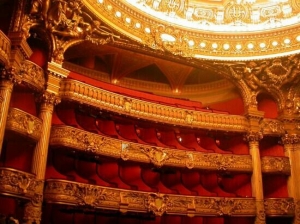
【Opéra Bastille】
One of the truly great venues for the performing arts anywhere in the world, Paris' new opera house actually managed to inspire some neighborhood protest during its planning and contruction. Pretty much everybody is a believer nowadays though. Check out the website for upcoming shows, it might even make sense to plan a trip to Paris around one.